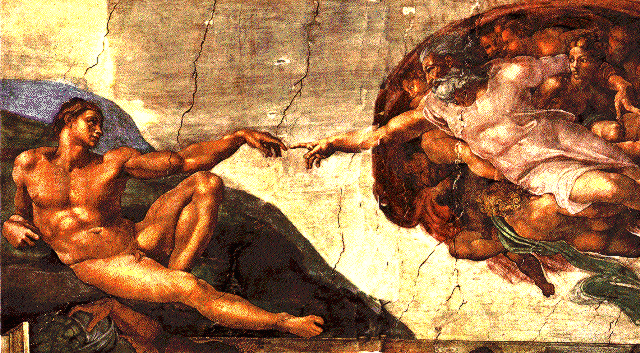 When the ancient astronomer Ptolemy (100-175 AD) woke up every morning, the Sun was coming up in the east. As his day wore on, the Sun moved across the sky and set in the west. All the stars and planets followed suit. It was perfectly obvious to Ptolemy and his contemporaries that the Earth was the pivot point around which the rest of the cosmos revolved. Copernicus’s so-called “revolution” (so-called because it wasn’t really the revolution it's been made out to be – but that’s a whole different story) stemmed from his claim that Ptolemy was mistaken and that the Earth actually revolved around the Sun. Later confirmation by Galileo proved the Copernican theory to be correct. But both Copernicus and Galileo were considered nutcases for challenging the “obvious,” expert-supported understanding of The Way Things Were. The idea that the Earth is the center of things was so ingrained in the minds of people it took a violent brain-shaking to overcome it.
When the ancient astronomer Ptolemy (100-175 AD) woke up every morning, the Sun was coming up in the east. As his day wore on, the Sun moved across the sky and set in the west. All the stars and planets followed suit. It was perfectly obvious to Ptolemy and his contemporaries that the Earth was the pivot point around which the rest of the cosmos revolved. Copernicus’s so-called “revolution” (so-called because it wasn’t really the revolution it's been made out to be – but that’s a whole different story) stemmed from his claim that Ptolemy was mistaken and that the Earth actually revolved around the Sun. Later confirmation by Galileo proved the Copernican theory to be correct. But both Copernicus and Galileo were considered nutcases for challenging the “obvious,” expert-supported understanding of The Way Things Were. The idea that the Earth is the center of things was so ingrained in the minds of people it took a violent brain-shaking to overcome it.I was reminded of the Ptolemy thing as I read a new book I would highly recommend to anyone interested in the topics discussed here – Benjamin Wiker & Jonathan Witt’s, A Meaningful World. The book is packed with scientific and historical insights about the abject failure of Naturalism/Materialism to account for the intricacy and wonder that exists in even the simplest forms of biological life. Their book is captivatingly successful in its mission to show “how the arts and sciences reveal the genius of nature,” but I particularly enjoyed the historical parallel they drew between previously accepted scientific “facts” and the presumptive acceptance of the Darwinist paradigm that pervades scientific inquiry today. Take phlogiston for instance.
In their primitive attempts to unmask and define the secrets of the elemental substances, the alchemists tried to unlock the compound relationships between the elements (earth, air and water) by using the fourth element (fire) to burn and melt all variety of things into investigatory submission. In this effort, Joseph Priestley became the primary promoter of Phlogiston Theory, a widely accepted explanation for the alchemists’ observations, in which flammable materials were held to contain phlogiston, a substance that was released in the burning process. Phlogiston theory made perfect sense ...
If, for example, you placed a lit candle under a glass globe, as Priestly and others had done so many times, eventually (so they maintained) all the phlogiston would be released from the candle and saturate the globe. When the air in the globe could hold no more phlogiston, the candle went out … [or, with] … regard to the burning of metal, since the pure metal burned red-hot, it must (supposedly) have phlogiston in it. As the phlogiston was steadily released, the metal degraded, like a burnt log. Thus, the metal was dephlogisticated … [and] turned to a whitish, chalky calx (Latin for chalk) that, when reheated with charcoal … would return to its pristine [re-phlogisticated] condition.
Priestly’s work in this area led to the discovery of oxygen, which we now know is the real culprit in answering the burning question. Interestingly, he is credited with discovering oxygen himself in most textbooks and history accounts. But Priestly actually went to his grave “vehemently denying that oxygen even existed.” He was too tied the phlogiston paradigm to accept the physical evidence provided by French chemist Antoine Lavoisier. Lavoisier explained not only the phenomena Priestly observed as being the result of burning oxygen, he devised a way to isolate oxygen, which led to the parallel discovery that oxygen and hydrogen combine to form water. He did so because he overturned the phlogistian paradigm that everyone else accepted. He insisted that phlogiston did not even exist and proved it experimentally.
Though I won’t go into it here, a similar story can be told about the existence of “ether.” Scientists (including Michelson and Morley) made all manner of attempts to explain the invariant measurements of the speed of light away by invoking ether-based explanations for their results. It wasn’t until the introduction of his Special Relativity theory that Einstein proposed the wildly controversial view that “there was no ether.”
Old theories die hard. In all these cases hold the following in common:
- The “commonly accepted” theory enjoyed popularity and unquestioned devotion among the scientific expert authorities of its day
- The old ideas were challenged by maverick researchers with evidence to back up their claims
- Those who held to the “commonly accepted” view belittled and ignored the new understanding primarily because it was a minority view
- The old view proved to be not only wrong, but wildly inconsistent with the real world
Twenty-twenty hindsight allows us to look back at Ptolemy and phlogiston as bizarre examples of goofy science. It’s hard to see from our point of view how in the world anyone could ever have been so stubbornly committed to them in the face of obviously condemning evidence. When you are firmly planted in a paradigm, human nature proves time and again that it is nearly impossible to extricate yourself from it. It’s hard to do. Human pride and the idolatry of human reason inhibit our ability to see things clearly. But good science, backed up by solid evidence, demands that we consider the possibility that we may be wrong.
Now it might be coincidence that both these examples of paradigm shift involve subjects (Ptolemy and phlogiston) with the weird silent and/or unusually pronounced “p” thing going on. There is no logical explanation for why this might be. But, considering the ramifications of these ideas and the parallels that can be drawn between them and the commonly accepted naturalistic worldview - vs - Intelligent Design debate, I would like to propose alternate spellings for some terms we have all come to so readily accept: Pnatural selection and Pneo-Pdarwinian evolution.
 Many Christians these days make a scene about boycotting Christmas. That's their choice but I'd like to humbly offer a rebuttal to the notion that all the Christmas symbols (trees, mistletoe, Santa Claus, gift-giving) and most notably the date, we use for Christmas are nothing but an acceptance of paganism with which no "real" Christian should agree. I don't accept that. Here's why ...
Many Christians these days make a scene about boycotting Christmas. That's their choice but I'd like to humbly offer a rebuttal to the notion that all the Christmas symbols (trees, mistletoe, Santa Claus, gift-giving) and most notably the date, we use for Christmas are nothing but an acceptance of paganism with which no "real" Christian should agree. I don't accept that. Here's why ...



 The AP news flash on my ISP homepage caught my eye yesterday:
The AP news flash on my ISP homepage caught my eye yesterday:







 OK, this is weird. I never thought I'd find a spiritual truth outlined and defended in Scientific American but I guess there is a first time for everything. There is no doubt that the editors did so unwittingly,
OK, this is weird. I never thought I'd find a spiritual truth outlined and defended in Scientific American but I guess there is a first time for everything. There is no doubt that the editors did so unwittingly,  Recently, my friend (though he may deny that descriptor of himself, I don’t) and former college roommate, who is running for Congress in the 29th District of New York, issued a
Recently, my friend (though he may deny that descriptor of himself, I don’t) and former college roommate, who is running for Congress in the 29th District of New York, issued a 